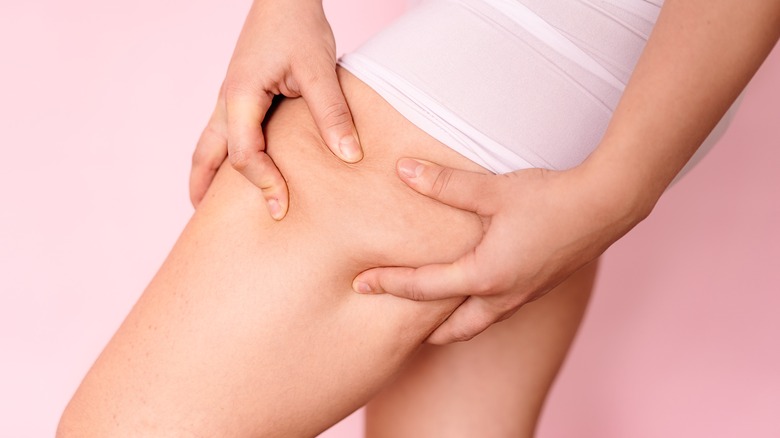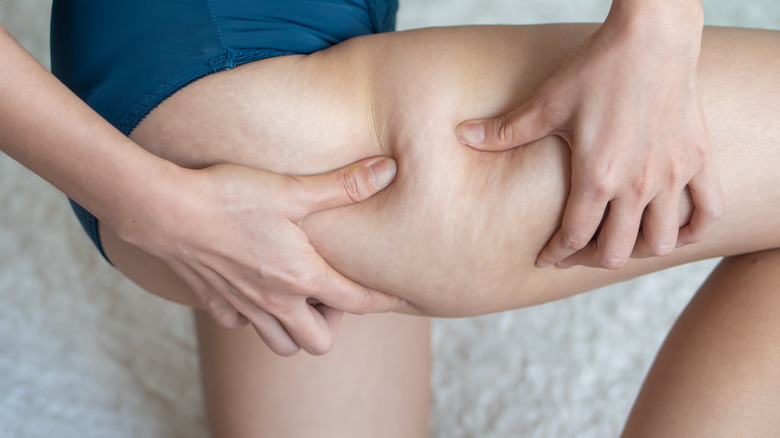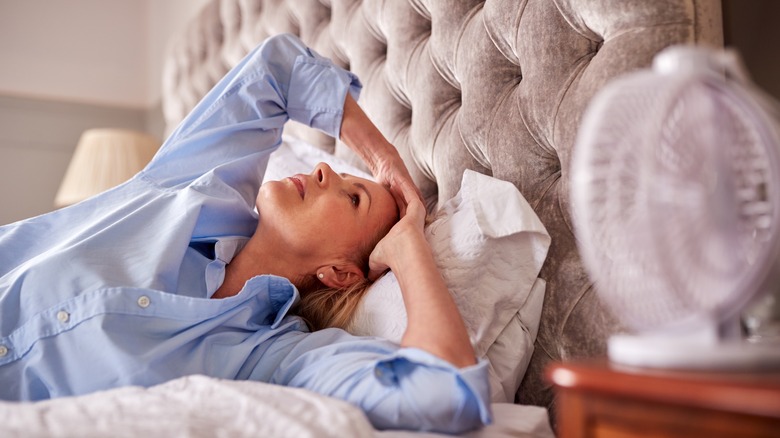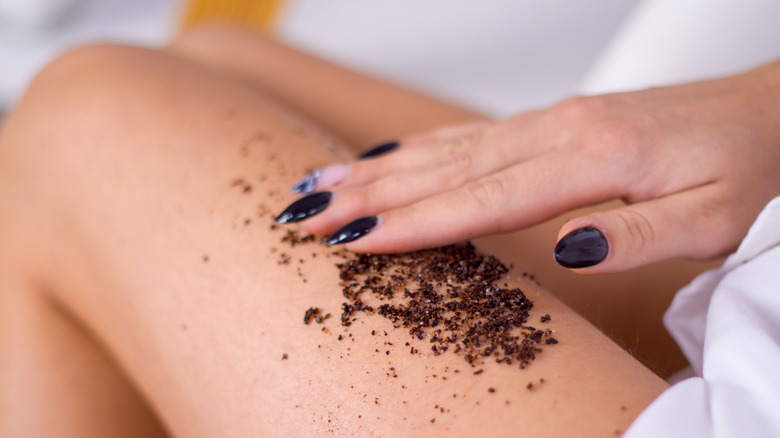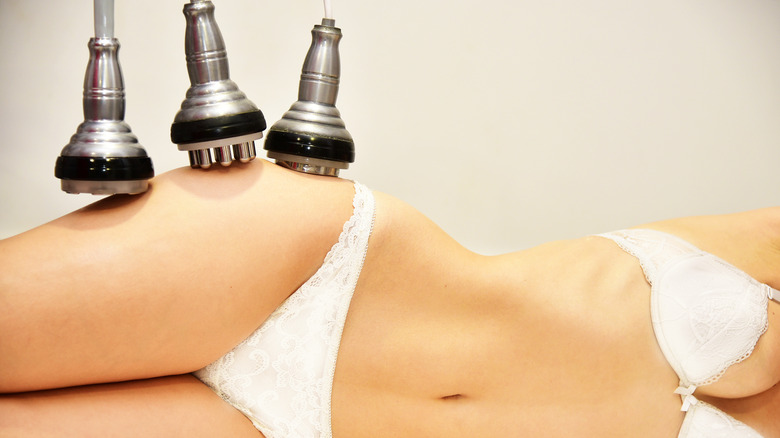Everything You Need To Know About What Cellulite Really Is
We may receive a commission on purchases made from links.
Most people can look at their bodies and point to areas where they have cellulite. It is both a common occurrence and a distinctive feature that can be found on various parts of the body. However, not everyone understands what cellulite is or why it shows up. As a result, misinformation about the harmless skin condition has run rampant for years, (via UNM). Tabloids, magazines, spa owners, and cosmetics companies have all made a big fuss about the commonplace skin dimples.
According to Bedsider, many businesses have taken advantage of this misunderstood obsession, throwing money at anti-cellulite marketing. They offer questionable tips and tricks for its erasure while calling out the slightest jiggle on the bodies of celebrities and media personalities. While some would have you believe cellulite is a toxic, fatty substance immune to everything but their patented brand of body lotion, the truth is much simpler. Here's everything you need to know about what cellulite really is, including what causes it, realistic treatment options, and tips for prevention.
What is cellulite?
Cellulite is a common cosmetic condition experienced by both men and women. According to MedlinePlus, cellulite is a build up of subcutaneous fat deposits that collect in pockets, giving the external layer of skin a lumpy or dimpled appearance. Cellulite is harmless but can cause anxiety when it is noticeable on the thighs, hips, butt, arms, and stomach.
It is physiological and varies in its severity. According to Medical News Today, cellulite is ranked by grades. The first grade is a mild case of cellulite. Skin with mild cellulite has a slightly sagging appearance with between one to four superficial depressions. Moderately severe cellulite, or second grade, consists of five to nine depressions and has a more obvious appearance. The third most severe grade results in deep depressions that cause the skin to drape.
The term cellulite was first coined in the late 1800s by French doctors Charles-Philippe Robin and Émile Littré (via Andrea Juarez). They published their findings about cellulite in the 12th edition of the "Dictionary of Medicine." At the time the term referred to cellular tissue that was prone to inflammation rather than a build-up of fat deposits. Despite this, cellulite went mainstream in the early 1900s thanks to the emerging French cosmetics industry. Articles in major fashion and beauty publications lamented the presence of this new unsightly fat while European health spas claimed to know how to remove it.
What causes cellulite?
Little is known about what causes cellulite, although the body's muscle and fat structures, hormones, diet, lifestyle, and microcirculatory system are all thought to contribute (via Genomelink). For example, people who smoke, don't get enough sleep, or have poor diets are more likely to have severe cellulite. The majority of elements that play a role in the development of cellulite are beyond our control.
Perhaps the most prevalent cause of cellulite is the inner structure of the body. Connective tissue below the skin binds and supports the body's tissues and organs. It consists of tough fibers and a variety of elastic, fatty, and cartilaginous tissues, per National Library of Medicine. These fibers and the way the connective tissue is arranged varies depending on the gender assigned at birth, and is a major contributor to the look and presence of cellulite. Fat cells push up against the skin as they accumulate while the connective fibers that tether the skin and the muscle pull down, leading to the skin's dimpled appearance.
It is a common misconception that cellulite is caused by being overweight. According to Mayo Clinic, cellulite also exists in people who are fit and at a healthy weight. However, it is thought that weight gain can make cellulite more obvious in appearance. Healthy weight loss through diet and exercise can help reduce the look of cellulite, but it cannot make it disappear.
The effect of estrogen, insulin, and the thyroid on cellulite
Cellulite can appear on the body even if someone goes the gym regularly, eats a supremely healthy diet, and abstains from drinking or smoking. This is possibly thanks to hormone imbalances with estrogen, insulin, and prolactin. The thyroid's functionality, or lack thereof, can also play a role.
Estrogen has multiple necessary roles within the body, including the development and maintenance of a healthy reproductive system (via Johns Hopkins Medicine). It also stimulates the breakdown of collagen. More estrogen, which is linked to higher body fat percentages, means less production of collagen and increases the appearance of cellulite, per My Skin & Body Clinic. During breastfeeding, the hormone prolactin decreases the body's ability to break fat down which can contribute to cellulite visibility. Furthermore, if the body is insulin resistant, meaning it cannot breakdown or process insulin, it will convert carbs into fat. The fat grows larger, pushing against the skin, leading to a lumpy appearance.
The thyroid is an endocrine gland with a variety of functions. According to Endocrine Web, a healthy thyroid helps maintain body weight, the nervous system, cholesterol levels, heart rate, and regulate metabolism. Its primary function is to produce, store, and release hormones into the bloodstream. If the thyroid gland isn't producing the right amount of hormones, it can cause the body's metabolic rate to slow down and increase the likelihood of cellulite in the fat storage areas of the body.
The role of genetics on cellulite
Genetics can also play a role in the existence and appearance of cellulite. If the women in your family have cellulite, it is extremely likely that you will develop the condition as well. Cellulite also affects Caucasian women more than Black or Asian women (via The Sydney Morning Herald).
According to Xcode Life, the HIF1A and angiotensin converting enzyme (ACE) genes have been identified as genes associated with cellulite risk, particularly in lean, healthy women. The HIF1A gene helps produce hypoxia-producing factor one proteins. This contributes to the condition hypoxia, which is when different areas of the body are deprived of oxygen. In periods of hypoxic conditions, there is a reduced flow of oxygen to fatty tissues which can increase the risk of cellulite over time.
The ACE gene contains instructions for the human skeletal muscle enzyme. According to CosmeticsDesign, a 2010 study found that healthy women with higher levels of the ACE variant in their bodies were more likely to have cellulite. This is because the higher levels of the ACE gene impact the blood flow to the fat tissue under the skin and alter the appearance of the skin at the surface.
Why do women get cellulite more than men?
Cellulite is a skin condition that appears in 90% of women, per Scientific American. Although men are not immune to cellulite, it is rare for them to have it. This is mainly due to the physical structure of men and women's bodies. In men, the fibers present in the body's connective tissues have a smooth, cross-hatched appearance, like a chain-link fence. This structure is strong and holds fat in better. Men also have 25% thicker, tougher skin than women as a result of the stimulation of androgen (via Dermalogica).
The fibers in a woman's body are arranged in a vertical fashion that runs perpendicular to the skin. This means that when the fat builds and starts pushing up against the skin, it is easier for it to press through the connective tissues (via Endo-Systems). Women also have naturally higher estrogen levels and produce more fat layers in areas of the body like the buttocks, stomach, and hips. Men only have one layer of fat throughout their bodies.
Menopause and cellulite
Menopause is a tough time for many women due to the number of changes the body undergoes. In addition to unpleasant conditions like hot flashes, moodiness, night sweats, and weight changes, cellulite can become more prevalent. According to Scientific American, when women approach menopause, the hormone estrogen begins to decrease. This decrease is responsible for increased vascular permeability and decreased vascular tone, both of which are needed for cellulite to develop (via Menopause Review). In other words, the reduction in estrogen decreases the production of collagen and elastin fibers in the skin, weakens the connective tissues, and causes the skin to become thinner.
During menopause, thinning skin makes it easier to develop the appearance of cellulite, per Hotze Health & Wellness Center. Furthermore, menopause causes the fat cells to change in a woman's body, which can also lead to weight gain and shifts in body composition. The change in weight can make existing cellulite more noticeable.
Over-the-counter cellulite treatments
Many women with cellulite wonder if it can be treated from the comfort of home. There are hundreds of beauty and cosmetic companies that claim to have the long-awaited over-the-counter cure for treating the dimpled skin of the hips and thighs, however many of these are said to be a waste of time and money. According to GoodRx Health, there are no existing creams proven to get rid of cellulite — at least not for good.
However, all is not lost. According to the American Academy of Dermatology, some skin products that contain caffeine may help dehydrate cells and tighten skin, reducing the appearance of cellulite over time. When applied topically, lotions and scrubs with caffeine are also thought to cause blood vessels to dilate which can contribute to a skin-smoothing effect (via Healthline). OTC products with retinol are also thought to be an effective temporary solution for altering the appearance of cellulite. Retinol, which is a form of vitamin A, is known to have anti-aging effects by increasing skin cell and collagen production. It also has exfoliating properties that are useful for smoothing fine lines and wrinkles, as well as reducing the appearance of acne scars. These products require a daily application to make any kind of progress.
Daily dry brushing and getting regular professional massages may also be beneficial for increasing blood circulation, detoxifying, and aiding digestion, all of which can help improve the appearance of cellulite.
In-office cellulite treatments
If your cellulite upsets you to the point of wanting to take more extreme treatments, the American Academy of Dermatology (AAD) also recommends several medical procedures that require in-office visits. These include laser treatments and subcision procedures. According to the AAD, certain laser treatments target the bands beneath the skin and break them apart. They may also thicken the external part of the skin, making it harder for the fat underneath to appear lumpy.
Subcision treatments use a needle rather than a laser to break up the bands beneath the skin and release the dimple. These types of treatments are particularly useful for treating cellulite on the backs of the thighs and buttocks. Per the American Society of Plastic Surgeons, liposuction and fat grafting procedures can temporarily improve the look of cellulite in some patients. However, most medical professionals agree that liposuction is not an effective treatment due to the type of fat cellulite is.
As with any invasive procedure, it is important to talk with your doctor to determine which is right for you. However, the results of these procedures are temporary, lasting anywhere from a few months to a couple of years. They can also cause swelling and bruising, in addition to being expensive.
Can cellulite be prevented?
As we've discovered, cellulite is likely to affect most women. It is caused by a variety of factors, many of which are out of our control such as age, genetics, gender, and hormones. However, if the sight of it bothers you, there are a few ways to prevent the severity of cellulite and its overall appearance.
Maintaining a healthy diet is one of the best ways to help prevent cellulite. According to Mount Sinai, a diet rich in lean protein, fiber, fruit, and vegetables is ideal for avoiding cellulite. Incorporating foods like dark leafy greens, grapefruit, berries, celery, and asparagus provide the necessary vitamins and nutrients the body needs to support healthy skin and weight. Healthy fats like salmon and avocado are great for improving the overall appearance and health of skin as well (via The Healthy). Drink plenty of water to keep the body hydrated and maintain a healthy weight by avoiding crash diets.
Although exercise is not a cure for cellulite, it is vital for maintaining strong bones and toning muscles. Regular physical activity may assist with weight loss by reducing the body's overall fat percentage as well. Building a strength training routine, particularly with moves that focus on the lower body, will firm up muscles and contribute to a skin-smoothing effect overtime, per CNN. Exercises like lunges, squats, calf raises, and deadlifts are great to help tone and strengthen the areas of the body most affected by cellulite.
The psychological and social impact of cellulite
Despite the fact that cellulite is both common and harmless, its presence can have a serious psychological and social impact on the men and women who have it. Cellulite affects people's self-confidence and body image, largely because they don't understand what it is or why it's so hard to get rid of (via Psychreg). In a world that is tough on less-than-perfect bodies, people with cellulite often assume they are doing something to cause the skin dimpling.
According to an article published in Surgical and Cosmetic Dermatology, roughly half of all people are unhappy with the appearance of their bodies. Cellulite doesn't help this. The emotional distress and negative feelings associated with cellulite can cause these individuals to suffer from eating disorders or seek unnecessary treatments at some point in their lives. Anxiety and depression are also common. People often feel uncomfortable wearing a bathing suit at the pool or shorts in the summertime, embarrassed by their skin's appearance. This can also lead to staying indoors and avoiding spending time with other people, which can negatively impact a person's quality of life.
The media's concern with physical appearance is cited as a trigger in many scenarios, as are images seen on social media (via Ipsos). The constant exposure to images of appearance-related content, such as those from a fitness influencer or model, may force the average user to think their dimpled thighs or hips are somehow undesirable.
If you or someone you know is struggling with mental health, please contact the Crisis Text Line by texting HOME to 741741, call the National Alliance on Mental Illness helpline at 1-800-950-NAMI (6264), or visit the National Institute of Mental Health website.
Why is cellulite considered unattractive?
If cellulite is truly harmless and just about every woman has it, why is cellulite considered so unattractive? There is no simple answer. However, society's beauty expectations and the culture of physical perfection certainly play a role.
The appearance of anything less than smooth, toned, blemish-free skin is often seen as a problem that must be fixed (via Boston Medical Center). Models are airbrushed and retouched to rid their images of cellulite. Countless articles can be found in print or online touting the best creams and cures to fight the presence of dimpled skin. Despite everything we know about the media's portrayal of the perfect body, as well as its powerful ability to shame imperfect ones, we are conditioned to believe others when they say our dimpled butts and thighs are unattractive.
Cultural acceptance of cellulite and its place on our bodies is key to changing the rhetoric behind its existence. Of course, massive change in regards to beauty ideals isn't easy. That is why many celebrities and influencers, including body-positive supermodel Ashley Graham, are working to shift the narrative. "I'm not ashamed of a few lumps, bumps or cellulite ... and you shouldn't be either," Graham writes on her Instagram. The body inclusivity movement is also helping to push real women's bodies, cellulite and all, into mainstream media. In the meantime, reframing how you view and talk to your body is a good place to start. Also, remember that cellulite is not a personal failure or a sign that you are unhealthy.
